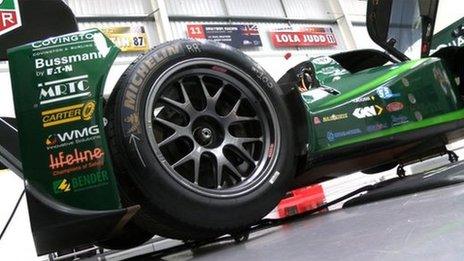Shhh! It's time for Formula E!
- Published
Theo Leggett takes a look at a Formula E car at Donington Park
If Formula E is the future, then the future is going to be a rather quiet place. But that may not necessarily be such a bad thing.
The new international championship for fully-electric racing cars is holding its first major test session this week, at the Donington Park circuit in Leicestershire.
The series kicks off with a race through the streets of Beijing in September. It will include events in 10 cities, concluding with an "E-prix" around London's Battersea Park next June.
Organisers hope it will transform the way we think about electric cars, as well as providing a test-bed for new technologies, which can help to improve their performance.
The Donington test marks the first time the cars have run in anger - and the first time members of the public have been able to see how they compare to more traditional racing machines.
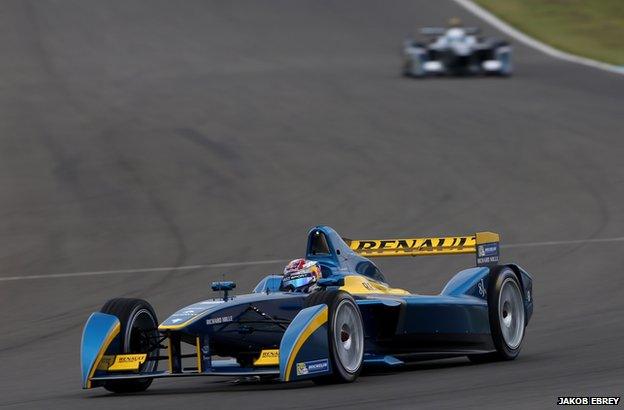
There will be an "E-prix" in London next year
At first glance, frankly, they don't seem all that remarkable. In terms of size and shape, they are broadly similar to Formula 1 cars, although there are some styling tweaks, including big fairings around the wheels, which give them an aggressive and purposeful look.
They certainly have a good pedigree. The 200 kilowatt (270bhp) electric motors are built by F1 giant McLaren's electronics division. The batteries come from another F1 team, Williams, and the chassis are built by Italian racing car constructor Dallara. They have a top speed of 140mph.
Muted whoosh
It isn't until they leave the pitlane, though, that you start to appreciate just how unusual they are.
There is no revving engine, no pungent smell of burned fuel or hot exhaust. Instead, there is a frantic, high-pitched whirring, rather like a turbocharged sewing machine.
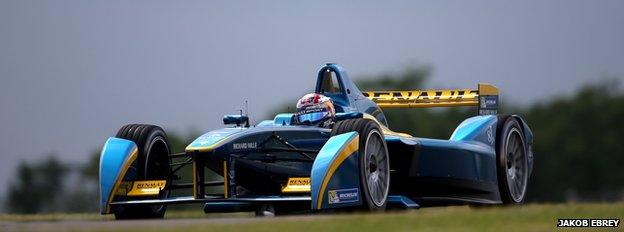
Drivers who get the most support on social media will get a temporary power boost
But once up to speed, the sound improves. Rather than the banshee wail or blaring roar of a conventional racing engine, there is a muted whoosh of disturbed air and a whistling noise that brings to mind a jet engine. It is certainly odd - but actually quite impressive.
For the drivers, too, there is something of a culture shock. British racer Katherine Legge, 34, has had a long and varied career, driving some of the most potent machinery available outside Formula 1. She admits her first few laps felt very strange.
"It's obviously very different," she says. "I'm used to big old grumbly engines, and this is silent. There's a bit of buffeting from the wind, but apart from that it's very quiet. But it's still a quick racing car."
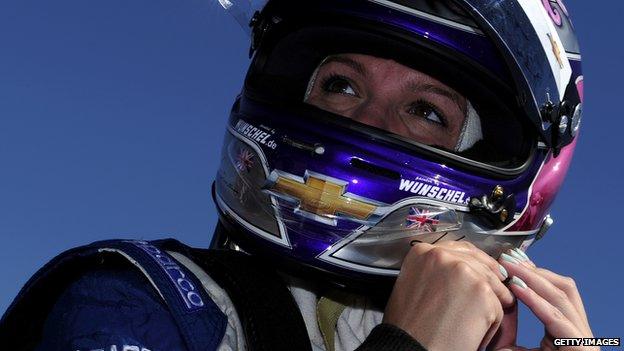
Racing veteran Katherine Legge was impressed with the new cars
However, according to Formula E's chief executive Alejandro Agag, the whole point of Formula E is that is designed to be different. For a start, the entire series has been conceived with a single overriding objective.
"Our goal is to have more electric cars in the streets of cities around the world. We think that electric cars can help solve the problems we have, like pollution and health problems.
"But the change to electric cars is too slow - so with Formula E, we want to accelerate the change to electric cars."
City streets
In order to do that, however, the series needs to build up a fanbase - something new motorsport championships often struggle to do, in a market dominated by Formula 1. But according to Mr Agag, Formula E is not actually trying to compete with existing championships.
"We are not necessarily looking for the motorsport fans here," he says. "We're looking for the younger generation. People who are looking for new things, and this is definitely new."
"We aren't going to be taking them from other forms of motorsport, because they aren't watching motorsport anyway."
This youthful appeal means races won't be taking place at established circuits. Instead, they'll be staged on city streets, where the public can get close to the action.
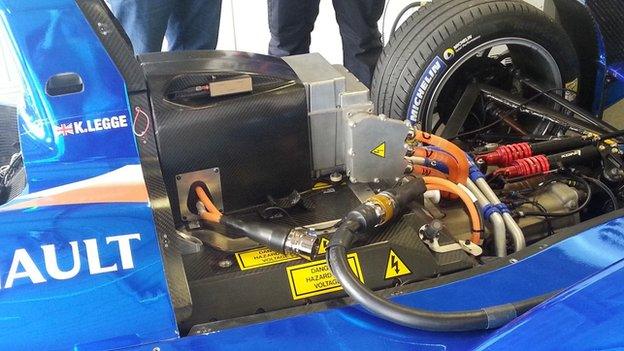
The cars don't make as much noise - but DJs will be on hand at races to solve that issue
Social media will play a big role, with fans able to vote for their favourite drivers online. The drivers who get the most votes will be given a temporary power boost to use during the race.
And while the cars themselves may be muted, each event will take place against a thumping musical backdrop. DJs will be on hand during the races themselves, while major artists will perform at evening concerts afterwards.
Among those who are hoping the concept works is Alain Prost, a four-time world champion in Formula 1. He is now the co-owner of the E-DAMS team in Formula E.
"I liked the concept very much," he says. "I wanted to see something really new, with new technologies. It doesn't mean I don't still love Formula 1, but I thought the time was right to do something very different."
The important point, according to Mr Agag, is that Formula E needs to develop its own niche - courting a tech-savvy generation who have few preconceived ideas about how motorsport should look.
"To compete with something like F1 is impossible in my opinion," he says.
"If you try, you will fail. So the key is not to compete with Formula One, but to be complementary. We have our own small niche next to it - with technologies that are completely different. We think we have that special uniqueness!"
Part of that uniqueness is certainly the lack of noise. But that could actually become an advantage. It is rare to leave a racing circuit without a certain amount of ringing in the ears and a little bit of temporary deafness.
So perhaps, when it comes to Formula E, less really could be more.
- Published4 July 2014
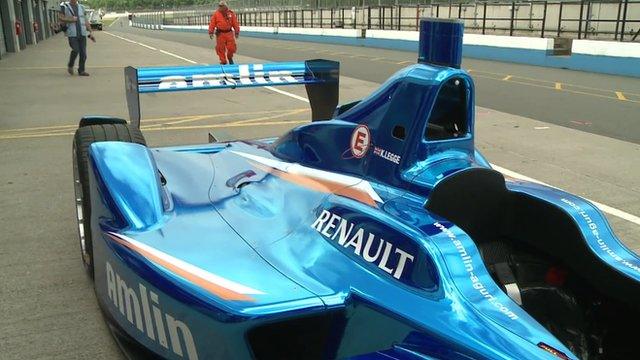
- Attribution
- Published3 July 2014
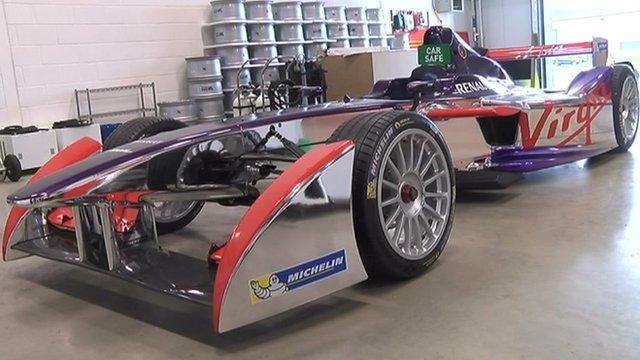
- Attribution
- Published15 June 2014
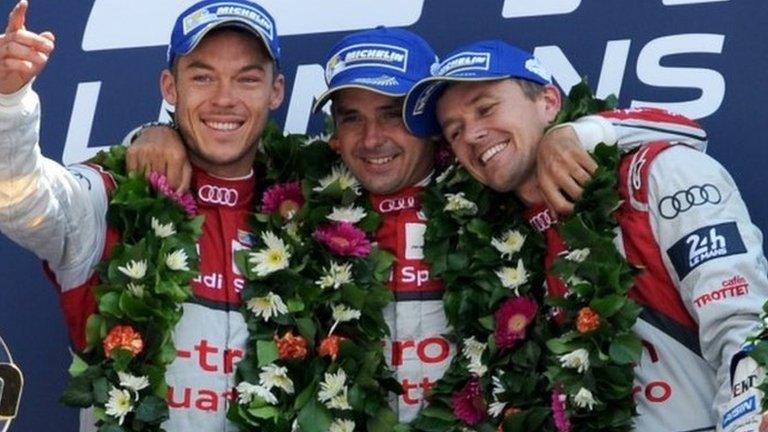
- Published23 May 2014
